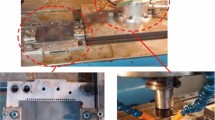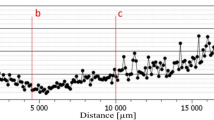Abstract
The main objective of this research work is to investigate size effects by downscaling the twist drilling process into the micro range (diameter: d = 50 μm to 1 mm). Therefore, experimental micro drilling tests in steel AISI 1045 (normalized and full-annealed) are performed with different cutting conditions (drill diameter, feed, cutting speed) and compared with data obtained from conventional drilling. Various size effects and its significant influence on the micro cutting process are characterized with help of the experimental results. Additionally, the formula of Victor–Kienzle is adjusted to model the feed force in micro drilling operations.








Similar content being viewed by others
References
Alting L, Kimura F, Hansen HN, Bissacco G (2003) Micro engineering. Ann CIRP 52(2):635–657
De Chiffre L, Kunzmann H, Peggs GN, Lucca DA (2003) Surfaces in precision engineering, microengineering and nanotechnology. Ann CIRP 52(2):561–577
Weule H et al (2004) International state of the art of micro production technology. Prod Eng Res Dev XI(1):29–36
Kopalinsky EM, Oxley PLB (1984) Size effects in metal removal processes. Institute of Physics Conference Series, vol n70, pp 389–396
Nakayama K, Tamura K (1968) Size effect in metal-cutting force. J Eng Ind. 119–126
Kountanya RK (2002) Process mechanics of metal cutting with edge radiused and worn tools, Ph.D. dissertation, University of Michigan
Klocke F, Lung D, Abouridouane M, Sangermann H (2008) Skalierungseffekte bei der Mikrozerspanung. VDI-Z Integrierte Produktion 150:42–43
Dornfeld D, Min S, Takeuchi Y (2006) Recent advances in mechanical micromachining. Ann CIRP 52(2):745–768
Klocke F, Gerschwiler K, Abouridouane M (2007) Size effects of the tool edge radius on specific cutting energy and chip formation in drilling. In: Vollertsen F, Yuan S (eds) Proceedings of the 2nd international conference on new forming technology. Bremen, pp 499–509
Kotschenreuther J (2008) Empirische Erweiterung von Modellen der Makrozerspanung auf den Bereich der Mikrobearbeitung. Dissertation, University of Karlsruhe
Hoppe S (2004) Experimental and numerical analysis of chip formation in metal cutting. Dissertation, RWTH, Aachen
Klocke F, Lung D, Gerschwiler K, Risse K, Abouridouane M (2006) 3D modeling and scaling effects in drilling. In: Nineth CIRP international workshop on modelling of machining operations, Bled Slovinienpp. 263–269
Kienzle O, Victor H (1957) Spezifische Schnittkrafte bei der Metallbearbeitung. Werkstofftechnik und Machinenbau 47(5):224–225
Author information
Authors and Affiliations
Corresponding author
Rights and permissions
About this article
Cite this article
Klocke, F., Gerschwiler, K. & Abouridouane, M. Size effects of micro drilling in steel. Prod. Eng. Res. Devel. 3, 69–72 (2009). https://doi.org/10.1007/s11740-008-0144-y
Received:
Accepted:
Published:
Issue Date:
DOI: https://doi.org/10.1007/s11740-008-0144-y




